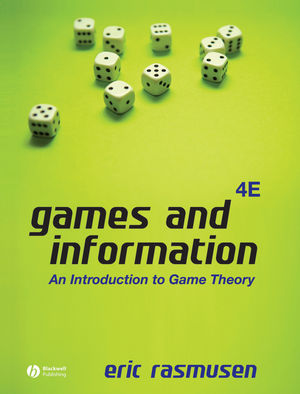|
Textbook
Games and Information: An Introduction to Game Theory, 4th EditionISBN: 978-1-4051-3666-2
Hardcover
560 pages
November 2006, ©2006, Wiley-Blackwell
 This is a Print-on-Demand title. It will be printed specifically to fill your order. Please allow an additional 10-15 days delivery time. The book is not returnable.
|
||||||
List of Tables.
List of Games.
Preface.
Contents and Purpose.
Changes in the Second Edition (1994).
Changes in the Third Edition (2001).
Changes in the Fourth Edition (2006).
Using the Book.
The Level of Mathematics.
Other Books.
Contact Information.
Acknowledgements.
Introduction.
History.
Game Theory’s Method.
Exemplifying Theory.
This Book’s Style.
Notes.
PART 1: GAME THEORY.
1. The Rules of the Game.
Definitions.
Dominated and Dominant Strategies: The Prisoner’s Dilemma.
Iterated Dominance: The Battle of the Bismarck Sea.
Nash Equilibrium: Boxed Pigs, The Battle of the Sexes and Ranked Coordination.
Focal Points.
Notes.
Problems.
Classroom Game.
2. Information.
The Strategic and Extensive Forms of a Game.
Information Sets.
Perfect, Certain, Symmetric, and Complete Information.
The Harsanyi Transformation and Bayesian Games.
Example: The Png Settlement Game.
Notes.
Problems.
Classroom Game.
3. Mixed and Continuous Strategies.
Mixed Strategies: The Welfare Game.
The Payoff-equating Method and Games of Timing.
Mixed Strategies with General Parameters and N Players: The Civic Duty Game.
Randomizing is not Always Mixing: The Auditing Game.
Continuous Strategies: The Cournot Game.
Continuous Strategies: The Bertrand Game, Strategic Complements, and Strategic.
Substitutes.
Existence of Equilibrium.
Notes.
Problems.
Classroom Game.
4. Dynamic Games with Symmetric Information.
Subgame Perfectness.
An Example of Perfectness: Entry Deterrence I.
Credible Threats, Sunk Costs, and the Open-Set Problem in the Game of Nuisance Suits.
Recoordination to Pareto-dominant Equilibria in Subgames: Pareto Perfection.
Notes.
Problems.
Classroom Game.
5. Reputation and Repeated Games with Symmetric Information.
Finitely Repeated Games and the Chainstore Paradox.
Infinitely Repeated Games, Minimax Punishments, and the Folk Theorem.
Reputation: The One-sided Prisoner’s Dilemma.
Product Quality in an Infinitely Repeated Game.
Markov Equilibria and Overlapping Generations: Customer Switching Costs.
Evolutionary Equilibrium: The Hawk-Dove Game.
Notes.
Problems.
Classroom Game.
6. Dynamic Games with Incomplete Information.
Perfect Bayesian Equilibrium: Entry Deterrence II and III.
Refining Perfect Bayesian Equilibrium in the Entry Deterrence and PhD Admissions Games.
The Importance of Common Knowledge: Entry Deterrence IV and V.
Incomplete Information in the Repeated Prisoner’s Dilemma: The Gang of Four Model.
The Axelrod Tournament.
Credit and the Age of the Firm: The Diamond Model.
Notes.
Problems.
Classroom Game.
PART 2: ASYMMETRIC INFORMATION.
7. Moral Hazard: Hidden Actions.
Categories of Asymmetric Information Models.
A Principal-agent Model: The Production Game.
The Incentive Compatibility and Participation Constraints.
Optimal Contracts: The Broadway Game.
Notes.
Problems.
Classroom Game.
8. Further Topics in Moral Hazard.
Efficiency Wages.
Tournaments.
Institutions and Agency Problems.
Renegotiation: The Repossession Game.
State-space Diagrams: Insurance Games I and II.
Joint Production by Many Agents: The Holmstrom Teams Model.
The Multitask Agency Problem.
Notes.
Problems.
Classroom Game.
9. Adverse Selection.
Introduction: Production Game VI.
Adverse Selection under Certainty: Lemons I and II.
Heterogeneous Tastes: Lemons III and IV.
Adverse Selection under Uncertainty: Insurance Game III.
Market Microstructure.
A Variety of Applications.
Adverse Selection and Moral Hazard Combined: Production Game VII.
Notes.
Problems.
Classroom Game.
10. Mechanism Design and Postcontractual Hidden Knowledge.
Mechanisms, Unravelling, Cross Checking, and the Revelation Principle.
Myerson Mechanism Design.
An Example of Postcontractual Hidden Knowledge: The Salesman Game.
The Groves Mechanism.
Price Discrimination.
Rate-of-return Regulation and Government Procurement.
Notes.
Problems.
Classroom Game.
11. Signalling.
The Informed Player Moves First: Signalling.
Variants on the Signalling Model of Education.
General Comments on Signalling in Education.
The Informed Player Moves Second: Screening.
Two Signals: The Game of Underpricing New Stock Issues.
Signal Jamming and Limit Pricing.
Countersignalling.
Notes.
Problems.
Classroom Game.
PART 3: APPLICATIONS.
12. Bargaining.
The Basic Bargaining Problem: Splitting a Pie.
The Nash Bargaining Solution.
Alternating Offers over Finite Time.
Alternating Offers over Infinite Time.
Incomplete Information.
Setting Up a Way to Bargain: The Myerson–Satterthwaite Mechanism.
Notes.
Problems.
Classroom Game.
13. Auctions.
Values Private and Common, Continuous and Discrete.
Optimal Strategies under Different Rules in Private-value Auctions.
Revenue Equivalence, Risk Aversion, and Uncertainty.
Reserve Prices and the Marginal Revenue Approach.
Common-value Auctions and the Winner’s Curse.
Asymmetric Equilibria, Affiliation, and Linkage: The Wallet Game.
Notes.
Problems.
Classroom Game.
14. Pricing.
Quantities as Strategies: Cournot Equilibrium Revisited.
Capacity Constraints: The Edgeworth Paradox.
Location Models.
Comparative Statics and Supermodular Games.
Vertical Differentiation.
Durable Monopoly.
Notes.
Problems.
Classroom Game.
Mathematical Appendix.
Notation.
The Greek Alphabet.
Glossary.
Formulas and Functions.
Probability Distributions.
Supermodularity.
Fixed Point Theorems.
Genericity.
Discounting.
Risk.
References and Name Index.
Subject Index



